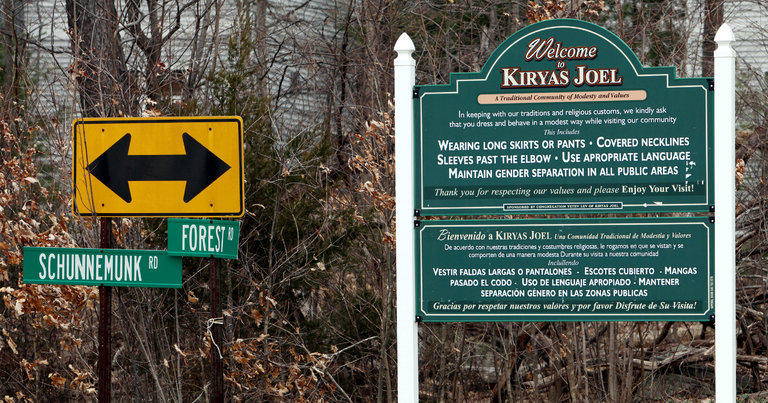The Hasidic School District That Was Created in Secret
By Sam Roberts
Even most New Yorkers have forgotten that Congress passed the Bill of Rights in New York. According to “The Curious Case of Kiryas Joel: The Rise of a Village Theocracy and the Battle to Defend the Separation of Church and State” (Chicago Review Press, $27.99), New York State is also where the “establishment clause” of the First Amendment’s freedom of religion protections was cynically abridged exactly two centuries later. Written by Louis Grumet with John Caher, the book recounts the political and constitutional maneuvering behind a state law passed in 1989 empowering the Satmar Hasidic enclave in Orange County to establish its own public school system. The insular, muscularly politically incorrect Satmars in the village of Kiryas Joel wanted, as the authors write, to have their cake and eat it, too — that is, to segregate the village from secular society while wringing every public service it might be entitled to from government. That presented a predicament: How to pay for the education of students with special needs who were ostracized because of their religious reclusiveness when they were assigned to classes in the secular school district. The State Constitution bars direct aid to parochial schools; the First Amendment to the United States Constitution prohibits government from passing any legislation that establishes a religion or prefers one to another. The authors recount how Democrats in Brooklyn, where the Satmar sect is based; George E. Pataki, then a Republican assemblyman in the Hudson Valley who was wooing the Hasidim, who vote as a bloc; and Gov. Mario M. Cuomo worked to establish “the first governmental unit in American history that was created solely to serve the needs and interests of only one religious group” — certain that the courts would overturn their largess. “As sure as I’m sitting here,” said Mel Miller, then the Assembly speaker, “I thought it was going to be vetoed, and if not vetoed then knocked out by the courts. Sometimes you make these political calculations — it’s just politics.” Mr. Cuomo rationalized. “It’s just a school for 13 poor, retarded immigrant children,” the authors quote him as saying. “Who’s going to sue?” he added. Mr. Grumet, executive director of the New York State School Board Association, did. Eventually, the United States Supreme Court voided the district; on its fourth appeal, the Legislature finally found a solution that seemed to pass constitutional muster. While the authors provide fascinating insights into raw politics and constitutional law, they do so largely through a single lens. Imagine how much more revealing the book would have been had Mr. Grumet and George Shebitz, counsel for the Kiryas Joel school district, been able to collaborate. In a word, is there a Brooklyn style? “Brooklyn Interiors” (Rizzoli International, $45), by Kathleen Hackett, suggests it might be renegade. She opens the borough’s front doors to reveal a vital diversity. “The single common thread,” she writes, “is a refusal — to follow the herd, to adopt trends, to strive for the neighbor’s sofa.”
|
.
Any original material on these pages is copyright © BishopAccountability.org 2004. Reproduce freely with attribution.
